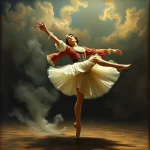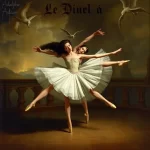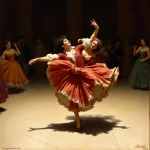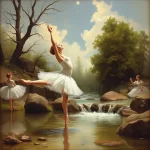Ballet: Don Quixote (Ludwig Minkus, 1869)

Introduction
Ballet: Don Quixote, composed by Ludwig Minkus and choreographed by Marius Petipa, premiered on December 26, 1869, at the Bolshoi Theatre in Moscow. This ballet, inspired by Miguel de Cervantes’ classic novel “Don Quixote,” is a vibrant and lively work that captures the essence of Spanish culture through its music and dance. The ballet follows the adventures of the chivalrous but delusional Don Quixote and his loyal squire, Sancho Panza, as they embark on a quest to find Don Quixote’s idealized love, Dulcinea. Along the way, they encounter a colorful cast of characters, including the spirited lovers Kitri and Basilio, whose romance becomes the central focus of the ballet.
Historical Background
Creation and Development
The creation of Don Quixote took place during a period of significant cultural and artistic development in Russia. The 19th century was a time when Russian ballet was evolving, influenced by both Western European traditions and local artistic movements. Marius Petipa, a French ballet master who had settled in Russia, was instrumental in shaping the future of Russian ballet. His collaboration with Ludwig Minkus, an Austrian composer known for his work in ballet music, resulted in a masterpiece that combined Petipa’s innovative choreography with Minkus’s evocative score.
The inspiration for the ballet came from Cervantes’ novel, which had already gained immense popularity across Europe. Petipa and Minkus sought to capture the novel’s whimsical and adventurous spirit while infusing it with the vibrant energy of Spanish dance and music. The collaboration between Petipa and Minkus was marked by a shared vision of creating a ballet that was both entertaining and artistically rich.
Premiere and Reception
Don Quixote premiered on December 26, 1869, at the Bolshoi Theatre in Moscow. The initial reception was overwhelmingly positive, with both critics and audiences praising the ballet for its lively choreography, engaging storyline, and captivating music. The ballet’s success led to numerous revivals and adaptations, solidifying its place in the repertoire of major ballet companies around the world.
Notable early performances included those by the Imperial Ballet in St. Petersburg, where the ballet continued to receive acclaim. Over the years, Don Quixote has been revived and reinterpreted by various choreographers, each bringing their unique perspective to the timeless tale.
Synopsis of the Ballet
Act I Summary
Act I introduces the audience to the bustling village square where Kitri, the innkeeper’s daughter, and Basilio, a poor barber, are in love. However, Kitri’s father, Lorenzo, has other plans for her and wants her to marry the wealthy but foolish Gamache. Don Quixote and Sancho Panza arrive in the village, and Don Quixote mistakes Kitri for his beloved Dulcinea. The act ends with a lively dance, as Kitri and Basilio manage to escape from Lorenzo and Gamache.
Act II Summary
Act II takes place in a gypsy camp where Kitri and Basilio seek refuge. Don Quixote and Sancho Panza also arrive at the camp, and Don Quixote, in his delusion, attacks a windmill, mistaking it for a giant. The act features a series of vibrant dances, including the famous Gypsy Dance. Eventually, Kitri and Basilio are discovered, and they continue their journey, with Don Quixote and Sancho Panza following closely behind.
Act III Summary
Act III is set in a tavern where Kitri and Basilio are finally reunited. However, Lorenzo and Gamache soon arrive, and Lorenzo insists on Kitri marrying Gamache. In a dramatic turn of events, Basilio pretends to commit suicide, and Kitri begs Don Quixote to persuade Lorenzo to let her marry Basilio. Moved by her plea, Don Quixote convinces Lorenzo to give his blessing. Basilio then miraculously “recovers,” and the act concludes with a grand wedding celebration.
Finale
The ballet concludes with a joyous wedding celebration, featuring a series of dazzling dances, including the famous Pas de Deux for Kitri and Basilio. The finale is a testament to the triumph of love and the enduring spirit of adventure embodied by Don Quixote.
Musical Composition
Composer’s Role
Ludwig Minkus, an Austrian composer, played a crucial role in the creation of Don Quixote. Known for his ability to compose music that perfectly complemented the choreography, Minkus crafted a score that was both lively and evocative. His music for Don Quixote is characterized by its rhythmic vitality and melodic richness, capturing the essence of Spanish culture and enhancing the narrative of the ballet.
Musical Themes and Motifs
The score of Don Quixote features several recurring musical themes and motifs that help to underscore the characters and their emotions. For example, the music associated with Don Quixote is often grand and heroic, reflecting his noble but misguided quest. In contrast, the music for Kitri and Basilio is lively and playful, capturing their youthful energy and love. The use of Spanish dance rhythms, such as the fandango and seguidilla, adds an authentic flavor to the score and enhances the overall atmosphere of the ballet.
Famous Recordings and Performances
Over the years, there have been numerous recordings and performances of Minkus’s score for Don Quixote. Some of the most iconic recordings include those conducted by Richard Bonynge and performed by the Orchestra of the Royal Opera House. These recordings have helped to preserve the musical legacy of the ballet and introduce it to new audiences.
Choreography and Dance
Choreographer’s Vision
Marius Petipa’s choreography for Don Quixote is renowned for its technical brilliance and expressive power. Petipa’s vision was to create a ballet that was both entertaining and artistically sophisticated, blending classical ballet technique with elements of Spanish dance. His choreography is characterized by its intricate footwork, dynamic leaps, and expressive gestures, all of which contribute to the storytelling.
Signature Dance Numbers
Don Quixote features several signature dance numbers that have become iconic in the world of ballet. One of the most famous is the Pas de Deux for Kitri and Basilio, which showcases the technical prowess and chemistry of the lead dancers. Other notable dances include the Gypsy Dance in Act II and the Grand Pas de Deux in the final act. These dances are not only visually stunning but also serve to advance the narrative and develop the characters.
Notable Interpretations
Over the years, different productions of Don Quixote have brought their unique interpretations to the choreography. Some have emphasized the comedic elements of the story, while others have focused on the romantic and adventurous aspects. Notable choreographers who have reinterpreted Don Quixote include Rudolf Nureyev and Alexander Gorsky, each bringing their distinct style and vision to the ballet.
Characters and Roles
Main Characters
- Don Quixote: The chivalrous but delusional knight who embarks on a quest to find his idealized love, Dulcinea.
- Sancho Panza: Don Quixote’s loyal squire, who provides comic relief and practical support.
- Kitri: The spirited innkeeper’s daughter who is in love with Basilio.
- Basilio: A poor but talented barber who loves Kitri and is determined to marry her.
Supporting Characters
- Lorenzo: Kitri’s father, who wants her to marry the wealthy Gamache.
- Gamache: A foolish but wealthy nobleman who seeks to marry Kitri.
- Gypsies: A group of lively characters who provide refuge for Kitri and Basilio in Act II.
Famous Dancers
Many renowned dancers have portrayed the roles in Don Quixote over the years. Some of the most notable include Rudolf Nureyev and Mikhail Baryshnikov as Basilio, and Natalia Osipova and Tamara Rojo as Kitri. These dancers have brought their unique interpretations to the roles, contributing to the ballet’s enduring popularity.
Cultural and Artistic Impact
Influence on Ballet and Dance
Don Quixote has had a significant influence on the world of ballet and dance. Its innovative choreography and vibrant music have inspired countless choreographers and dancers. The ballet’s blend of classical technique with elements of Spanish dance has also contributed to the development of new styles and forms within the art of ballet.
Cultural Significance
Beyond its impact on ballet, Don Quixote holds a special place in popular culture. The character of Don Quixote has become a symbol of idealism and the pursuit of noble dreams, resonating with audiences across different media. The ballet has been adapted into various forms, including film and theater, further cementing its cultural significance.
Legacy and Revivals
Don Quixote continues to be performed and celebrated by ballet companies around the world. Major revivals and reinterpretations have kept the ballet fresh and relevant for contemporary audiences. Its enduring appeal lies in its combination of technical brilliance, engaging storytelling, and vibrant music.
Iconic Productions
Historic Productions
Some of the most famous historical productions of Don Quixote include those by the Bolshoi Ballet and the Mariinsky Ballet. These productions featured legendary dancers such as Galina Ulanova and Maya Plisetskaya, who brought their exceptional talent to the roles of Kitri and Basilio.
Contemporary Productions
Recent productions of Don Quixote have continued to captivate audiences with their innovative interpretations. Companies like the American Ballet Theatre and the Royal Ballet have staged acclaimed performances, often incorporating modern elements while staying true to the original spirit of the ballet.
Production Design
The set, costume, and lighting design in various productions of Don Quixote have played a crucial role in bringing the story to life. From the vibrant village square to the enchanting gypsy camp, the production design enhances the visual and emotional impact of the ballet. Notable designers such as Nicholas Georgiadis and Santo Loquasto have contributed their creative vision to different productions.
Critical Reception and Reviews
Initial Critical Response
At the time of its premiere, Don Quixote received positive reviews from critics who praised its lively choreography, engaging storyline, and captivating music. The ballet was seen as a refreshing addition to the repertoire, offering both entertainment and artistic sophistication.
Modern Reviews
Contemporary critics and audiences continue to appreciate Don Quixote for its technical brilliance and vibrant energy. The ballet remains a favorite among dancers and choreographers, who admire its challenging choreography and expressive potential. Its enduring popularity is a testament to its timeless appeal and artistic significance.
Fun Facts and Trivia
Behind-the-Scenes Stories
One interesting anecdote from the production of Don Quixote involves the famous windmill scene. During one performance, the windmill prop malfunctioned, causing Don Quixote to “battle” an immobile windmill. The dancers’ quick thinking and improvisation turned the mishap into a memorable moment for the audience.
Notable Performers
Over the years, many famous dancers have been associated with Don Quixote. Rudolf Nureyev’s portrayal of Basilio is particularly legendary, as he brought his exceptional technique and charisma to the role. Similarly, Natalia Osipova’s Kitri has been celebrated for its fiery energy and technical precision.
Trivia
- Don Quixote was one of the first ballets to incorporate elements of Spanish dance, such as the fandango and seguidilla.
- The character of Don Quixote has been portrayed by both male and female dancers in different productions.
- The ballet’s famous Pas de Deux is often performed as a standalone piece in ballet galas and competitions.
Conclusion
Summary of the Ballet’s Importance
Don Quixote is a significant work in the world of ballet, known for its technical brilliance, engaging storytelling, and vibrant music. Its blend of classical ballet technique with elements of Spanish dance has influenced countless choreographers and dancers, contributing to the development of new styles and forms within the art of ballet.
Final Thoughts
Don Quixote remains a beloved and enduring work, captivating audiences with its lively energy and timeless appeal. Whether you are a seasoned ballet enthusiast or a newcomer to the art form, watching a performance of Don Quixote is a delightful experience that showcases the beauty and power of dance. We encourage readers to seek out a performance or listen to the score to fully appreciate the magic of this iconic ballet.
FAQ
What is the central theme of this ballet?
The central theme of Don Quixote is the pursuit of noble dreams and the triumph of love. The ballet follows the adventures of Don Quixote as he embarks on a quest to find his idealized love, Dulcinea, while also focusing on the romance between Kitri and Basilio.
Who are the main characters in this ballet?
The main characters in Don Quixote are Don Quixote, Sancho Panza, Kitri, and Basilio. Don Quixote is a chivalrous but delusional knight, Sancho Panza is his loyal squire, Kitri is the spirited innkeeper’s daughter, and Basilio is a poor but talented barber who loves Kitri.
What is the most famous dance number in this ballet?
The most famous dance number in Don Quixote is the Pas de Deux for Kitri and Basilio. This technically challenging and visually stunning dance showcases the chemistry and skill of the lead dancers and is often performed as a standalone piece in ballet galas and competitions.
How long does a typical performance of this ballet last?
A typical performance of Don Quixote lasts approximately two to three hours, including intermissions. The ballet is usually performed in three acts, with each act featuring a series of lively dances and engaging scenes.
Are there any modern adaptations of this ballet?
Yes, there have been several modern adaptations of Don Quixote. Choreographers like Rudolf Nureyev and Alexander Gorsky have reinterpreted the ballet, bringing their unique styles and perspectives to the classic work. Contemporary productions often incorporate modern elements while staying true to the original spirit of the ballet.
Why is this ballet considered important in the history of dance?
Don Quixote is considered important in the history of dance because of its innovative choreography, vibrant music, and engaging storytelling. The ballet’s blend of classical technique with elements of Spanish dance has influenced countless choreographers and dancers, contributing to the development of new styles and forms within the art of ballet. Its enduring popularity and cultural significance further underscore its importance in the world of dance.





